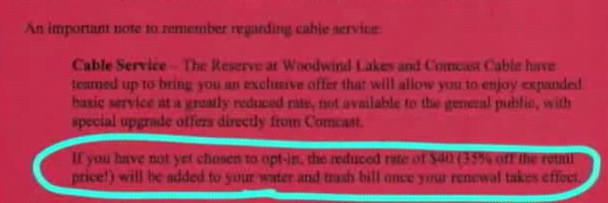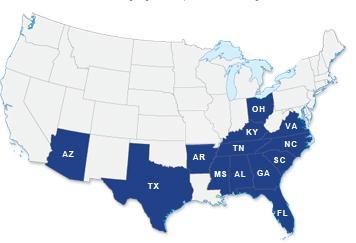 Comcast subscribers in cities across the country are getting as hot as the summer as they learn the cable company is jacking up prices again — for many the second time in a year. This time, the rate hikes are blamed on the cost to deliver an expanded lineup of HD channels, increased programming costs, and new cable modems. Yet on the eve of the European Union approving a proposed Comcast-NBC Universal merger, many Comcast cable customers are beginning to wonder if all of these rate hikes are going to pay for that deal.
Comcast subscribers in cities across the country are getting as hot as the summer as they learn the cable company is jacking up prices again — for many the second time in a year. This time, the rate hikes are blamed on the cost to deliver an expanded lineup of HD channels, increased programming costs, and new cable modems. Yet on the eve of the European Union approving a proposed Comcast-NBC Universal merger, many Comcast cable customers are beginning to wonder if all of these rate hikes are going to pay for that deal.
Here is a sampling of press reports from across the country on the latest round of increases:
San Francisco Chronicle: Comcast Corp. said it is raising rates for California cable and Internet customers by an average of 3.8 percent starting Aug. 1. The average video customer will see their monthly bill increase by $2.49 from $60.76 to $63.25 a month. Internet service will also increase for the first time in five years from $44.72 to $46.67 a month, a $1.95 increase. Andrew Johnson, regional vice president for Comcast California, said the increase is necessary to pay for more programming choices, new features, faster Internet speeds and improvements to customer service. The last rate increase came October 15, 2009 when rates went up just over 1 percent.
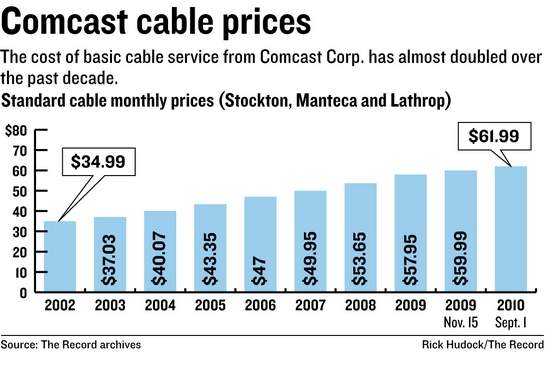 The Record (Stockton, Calif.): For the second time in less than 10 months, Comcast Corp. customers in San Joaquin County face price increases for cable television service and, for the first time in five years a boost in charges for a cable Internet connection, the company announced recently. Customers in Stockton, Manteca, Lathrop and San Joaquin County served by Comcast will see an increase of nearly 4 percent in their cable bills beginning Sept. 1. Notices began going out to subscribers late last week. Other Northern California areas served by the cable giant will see prices change Aug. 1.
The Record (Stockton, Calif.): For the second time in less than 10 months, Comcast Corp. customers in San Joaquin County face price increases for cable television service and, for the first time in five years a boost in charges for a cable Internet connection, the company announced recently. Customers in Stockton, Manteca, Lathrop and San Joaquin County served by Comcast will see an increase of nearly 4 percent in their cable bills beginning Sept. 1. Notices began going out to subscribers late last week. Other Northern California areas served by the cable giant will see prices change Aug. 1.
“They’ve got you tied in,” said Art Hickey of Stockton, who has five television sets in his home and subscribes to the highest tier of digital service. “They tease you with those six-month deals and 12-month deals and they don’t say what it’s going to be after that. People buy into it and then they’re just stuck with it,” he said.
So why not try another source of television?
“I haven’t compared, and I don’t want to because it’s a nuisance,” Hickey said.
The Spokesman-Review (Spokane, Wash.): Most of Spokane’s Comcast subscribers will see price increases in their Internet and video services effective in August, the cable company announced. Comcast’s last price increase went into effect October 2009. According to Comcast spokesman Walter Neary, most Spokane cable television subscribers will see an average monthly increase of about $3.21, or 4.9 percent. Customers who subscribe to Limited Basic, the least expensive package of Comcast TV channels, will have no increase in their monthly bill. Limited Basic includes all over-the-air local stations and the public, education and government channels.
Customers who pay for Comcast cable Internet will see two increases – a modem rental fee that will rise to $7 from $5 per month, and a $3 hike for monthly Web service. Subscribers who bundle Internet with either Comcast voice or TV service won’t pay the $3 hike, but will still see the modem fee increase, Neary said. Subscribers can eliminate the modem fee by buying their own modem. The Internet price hike reflects increased investment by Comcast in additional security services for subscribers and technology upgrades, Neary said. Another price increase, not reflected in Comcast’s stated 4.9 percent average monthly hike, is a $2 hike in the “HD technology fee.” TV subscribers who see HD Comcast channels will pay $8 per month for that technology fee, said Neary.
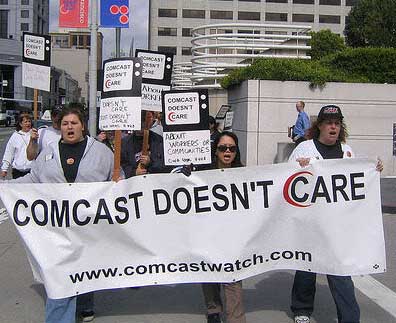 York Daily Record (York, Penn.): Comcast Cable is about three weeks away from putting into effect its second price increase in less than one year. On Aug. 1, the company will boost the average York County customer’s bill by roughly 3.5 percent, said Bob Grove , a spokesman for Comcast Cable’s Keystone Region. That increase is on top of a 1.9 percent price hike for the average Comcast customer that took effect Nov.1. The current rate increase is rooted in Comcast’s company-wide digital upgrade that calls for a jump in the number of high-definition channels to climb from 50 to 100, Grove said. Also, Comcast’s on-demand video menu will increase from 18,000 choices, 4,000 of which are HD, to 20,000 selections with 5,000 of those coming in as high-definition, he said.
York Daily Record (York, Penn.): Comcast Cable is about three weeks away from putting into effect its second price increase in less than one year. On Aug. 1, the company will boost the average York County customer’s bill by roughly 3.5 percent, said Bob Grove , a spokesman for Comcast Cable’s Keystone Region. That increase is on top of a 1.9 percent price hike for the average Comcast customer that took effect Nov.1. The current rate increase is rooted in Comcast’s company-wide digital upgrade that calls for a jump in the number of high-definition channels to climb from 50 to 100, Grove said. Also, Comcast’s on-demand video menu will increase from 18,000 choices, 4,000 of which are HD, to 20,000 selections with 5,000 of those coming in as high-definition, he said.
“We’ve continually invested in next-generation technology to support new product features, more programming choices and improvements to customer service,” according to a statement released by Comcast concerning the increase. However, for those currently enrolled in a Comcast promotion, your bill will remain unchanged until that particular deal ends, Grove said. “Nearly half of all Comcast customers are on some kind of promotion,” he said.
Public Opinion (Chambersburg, Penn.): Many Comcast customers will see an increase in their monthly bills starting next month. The average customer bill in the Chambersburg area will increase by about 3.5 percent, according to a company spokesperson. The new rates take effect Aug. 1. A customer with standard cable or digital starter service will now pay $63.50 a month, or $3.50 more. Expanded basic, digital preferred, digital premier and total premium services are also increasing by $3.50 a month. Limited basic service, digital economy and family tier services are not affected. Economy, Performance and Blast! tiers of high-speed Internet will be increasing $2 a month. Monthly prices for the Ultra and Extreme 50 tiers will not change. Digital voice services will also cost $1.95 more a month.
Centre Daily Times (State College, Penn.): Comcast this week started sending out another round of mailings notifying customers of another change. But this time around the mailing isn’t warning of an impending digital conversion, or announcing the addition of more high definition television channels. This time around, it’s a notification of a rate increase. Effective Aug. 1, the average price for Comcast in the State College area will go up about 3.5 percent.
The company cited technology and infrastructure investments when contacted for comment. “These investments make it possible to deliver continued innovations, such as more HD and On Demand choices, converged services, faster Internet speeds, multi-platform content and new services consumers want and value,” said Bob Grove, director of public relations for the Keystone region of Comcast. Grove said the recent digital conversion by the company was one of the cost factors, as well as other programs that have included increasing Internet speeds for customers in the area. He noted that bills for customers whose service operates under one of the company’s promotions will not be affected until the promotion period expires.
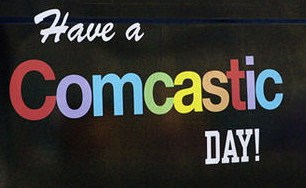 Appeal Democrat (Marysville, Calif.): Cable giant Comcast plans to raise prices nearly across the board for Yuba-Sutter residents for cable television and Internet service, effective Aug. 1. The Philadelphia-based corporation posted public notices in the Appeal-Democrat last week notifying rates would rise for its monthly cable and Internet rates, though two bundle packages will actually drop by about $20. Limited basic cable service, for example, will go from $15.40 to $16.85, while the digital premier package will go from $66.95 to $69 a month. A basic Internet package will go from $24.95 to $26.95, while a “performance” Internet package will rise from $57.95 to $59.95. Customers who bundle digital premier-level service and Internet or digital premier and phone service will see a reduction, from $195.10 and $197.10 a month, respectively, to $174.94 for either package.Some customers at the company’s Yuba City office Thursday said they weren’t aware of the pending price hike, though not all of them were overly surprised, either. “It’s gone up once every year for awhile now,” said Anthoney Stark, 42, of Marysville. “If they’re adding more channels, I don’t mind it.”
Appeal Democrat (Marysville, Calif.): Cable giant Comcast plans to raise prices nearly across the board for Yuba-Sutter residents for cable television and Internet service, effective Aug. 1. The Philadelphia-based corporation posted public notices in the Appeal-Democrat last week notifying rates would rise for its monthly cable and Internet rates, though two bundle packages will actually drop by about $20. Limited basic cable service, for example, will go from $15.40 to $16.85, while the digital premier package will go from $66.95 to $69 a month. A basic Internet package will go from $24.95 to $26.95, while a “performance” Internet package will rise from $57.95 to $59.95. Customers who bundle digital premier-level service and Internet or digital premier and phone service will see a reduction, from $195.10 and $197.10 a month, respectively, to $174.94 for either package.Some customers at the company’s Yuba City office Thursday said they weren’t aware of the pending price hike, though not all of them were overly surprised, either. “It’s gone up once every year for awhile now,” said Anthoney Stark, 42, of Marysville. “If they’re adding more channels, I don’t mind it.”
But Lori Switt of Yuba City reacted with dismay as she surveyed the list of price changes. “Each one of them added up …” she said. “We might have to switch.” She said paying more for cable and Internet is a tough pill to swallow when her boyfriend, a state worker, may have his pay reduced because of budget squabbles and she is only working part-time.
The price hike comes on the heels of Comcast dropping analog services in the Mid-Valley last month, angering many residents who said they hadn’t gotten proper notice. John Simpson, consumer advocate with nonprofit group Consumer Watchdog, said it was particularly galling for Comcast to raise its most basic cable package by the highest percentage, from $15.40 a month to $16.85. “In times like these, when people are hard-pressed, companies ought not to stick it to their basic cable customers,” he said. He also questioned the supposed upgrades in equipment, noting Comcast should take any money it makes in higher rates and apply it to customer service instead. Comcast is frequently listed among companies with the highest levels of customer dissatisfaction.
The Times Leader (Wilkes-Barre, Penn.): Most Comcast cable television customers will see an increase in most rates and services on Aug. 1. The Standard Cable and Digital Starter prices will increase by 5.7 percent while the Total Premium Package will rise to $136.90, a 2.6 percentage increase. The Value Plus Triple Play price, which includes Digital Starter, Performance High Speed Internet Service and CDV, will increase by 4.3 percent to $119.99. Expanded Basic Service, a popular package, will rise 6.8 percent to $55.05.
Comcast released the following statement: “We’ve continually invested in next-generation technology to support new product features, more programming choices and improvements to customer service. These investments make it possible to deliver continued innovations such as more HD and On Demand choices, converged services, faster Internet speeds, multi-platform content and new services consumers want and value.”
Although prices for premium services like HBO and Showtime as well as most installation and equipment rental charges will remain the same, Comcast stated that bills will increase by an average of 3.5 percent. Comcast did not comment when their new prices would be released to the public. Most rates increased between 2.6 and 6.8 percent.Comcast provides service in the northern portions of Luzerne County, including some West Side communities, the Back Mountain and the Pittston area. The company declined to say how many subscribers it serves.
The Press Democrat (Santa Rosa, Calif.): Like clockwork, Comcast is raising its prices, for the 10th time in 10 years. And like clockwork, customers are fuming.
“Here we go again,” said customer Aileen Bianchini, 84, of Santa Rosa. “It is out of line,” said Doris Trucco, a retired senior citizen in Santa Rosa. “I think a lot of us are unhappy. They just keep raising it.”
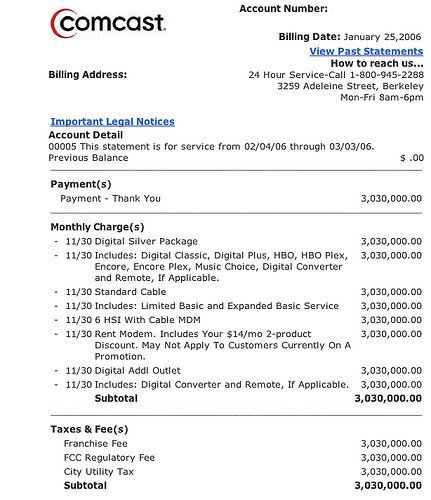 The nation’s largest cable TV company announced Friday that rates would increase 3.8�percent, on average, across Sonoma County on Aug. 1. Bianchini and others complained that a decade of price hikes haven’t resulted in much better service, just additional low-quality stations. But Comcast spokesman Andrew Johnson said the company has invested more than $600 million in Northern California in recent years to increase Internet speeds, add high-definition channels and deliver a host of new digital tools such as movies on demand.
The nation’s largest cable TV company announced Friday that rates would increase 3.8�percent, on average, across Sonoma County on Aug. 1. Bianchini and others complained that a decade of price hikes haven’t resulted in much better service, just additional low-quality stations. But Comcast spokesman Andrew Johnson said the company has invested more than $600 million in Northern California in recent years to increase Internet speeds, add high-definition channels and deliver a host of new digital tools such as movies on demand.
“We can give our customers the best in voice, video and data,” Johnson said. “We’re a heck of a value.”
Comcast is dropping the price on one of its budget options, called Digital Economy, from $39.95 to $29.95. But it is raising the price on its Internet service for the first time in five years. The minimum price jumps from $24.95 to $26.95, and the high-end price jumps from $67.95 to $69.95.
Tina Jackson of Cloverdale said she calls Comcast about every four months to ask for a new promotional package. If they say no, she threatens to cancel. “It doesn’t always work,” she said. But if customers are willing to go through with it, they usually find that the last customer service person they talk to as Comcast processes the cancellation will offer them a great deal, she said. “I’ve saved $50 a month,” Jackson said.
The Seattle Times: Fireworks will go off as soon as Comcast customers open their next bill. The company is raising rates an average of $3.21 per month, or 4.9 percent. It’s also raising the fee to rent a cable modem by $2 a month. Comcast just announced that it will be notifying its 1.1 million customers in Washington of the new rates, which take effect Aug. 1. The statement from spokesman Steve Kipp:
“We continue to invest in next-generation technology to support new product features, more programming choices and improvements to customer service. These investments make it possible to deliver continued innovations such as more HD and On Demand choices, converged services, multi-platform content, faster Internet speeds and new services consumers want and value. As a result of these investments, combined with the increased cost of doing business and rising programming costs, the average customer bill will increase by 4 percent.”
Digital Starter — the most common package — is increasing in price $3.54, from $57.45 to $60.99. People who get barebones, absolute basic cable won’t see a price increase. Those plans will stay $13 to $18 per month, depending on where you live. For people who subscribe only to Comcast broadband, and not its TV service, there will be a $3 per month increase “to standardize our pricing with other Comcast regions around the country,” Kipp said via e-mail. Those who get the “Digital Economy” package will get a break. Their rates will decline, ranging from 4 cents per month to $10.04 per month, depending on their bundle, because Comcast is standardizing this service tier at $29.95 per month. Digital Economy includes the limited basic channels but 17 digital cable channels, including Food Network, History, Disney Channel, Lifetime, AMC and USA.
 Now, according to the Berkshire Eagle, Lee’s representative to the Five Town Cable Television Advisory Committee is calling out Time Warner, claiming they are misinterpreting the town’s franchise agreement and wants the Lee Board of Selectman to start imposing fines against the cable company if they don’t relent within 30 days.
Now, according to the Berkshire Eagle, Lee’s representative to the Five Town Cable Television Advisory Committee is calling out Time Warner, claiming they are misinterpreting the town’s franchise agreement and wants the Lee Board of Selectman to start imposing fines against the cable company if they don’t relent within 30 days.

 Subscribe
Subscribe













